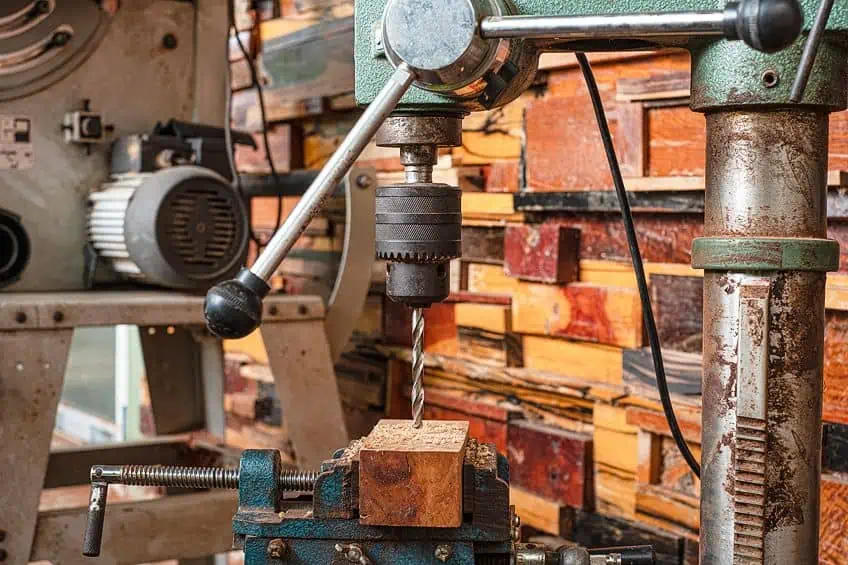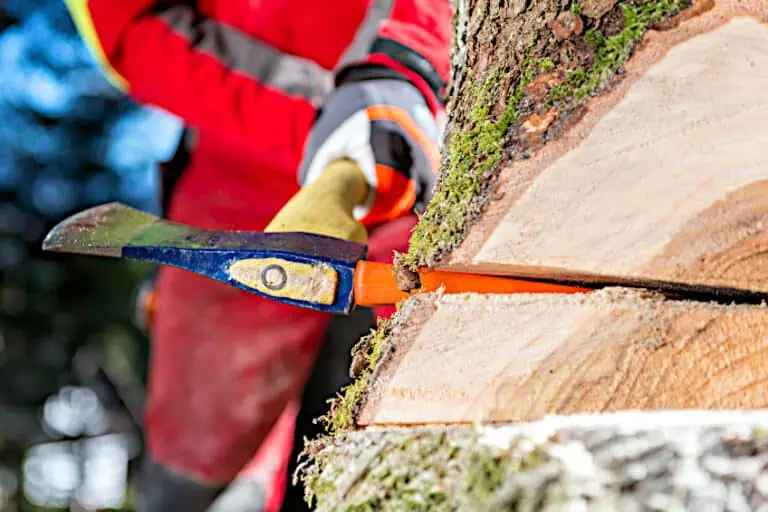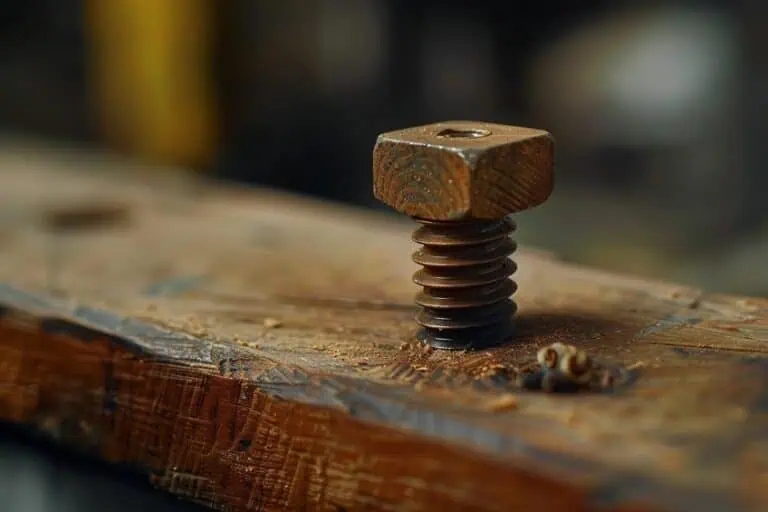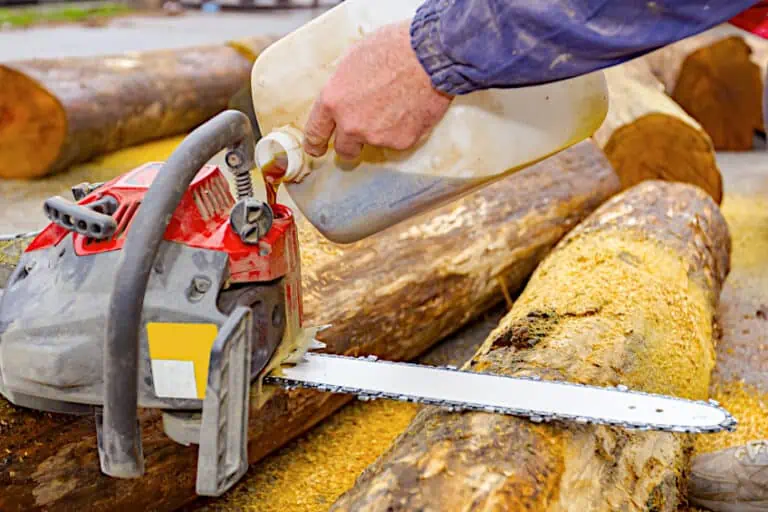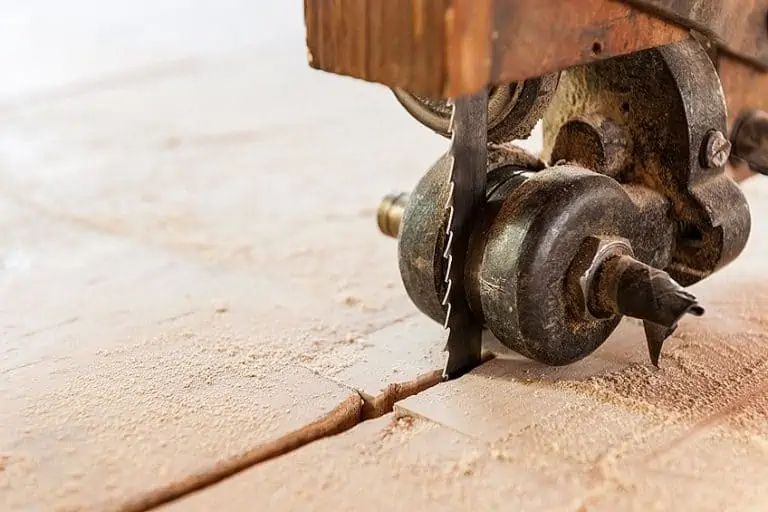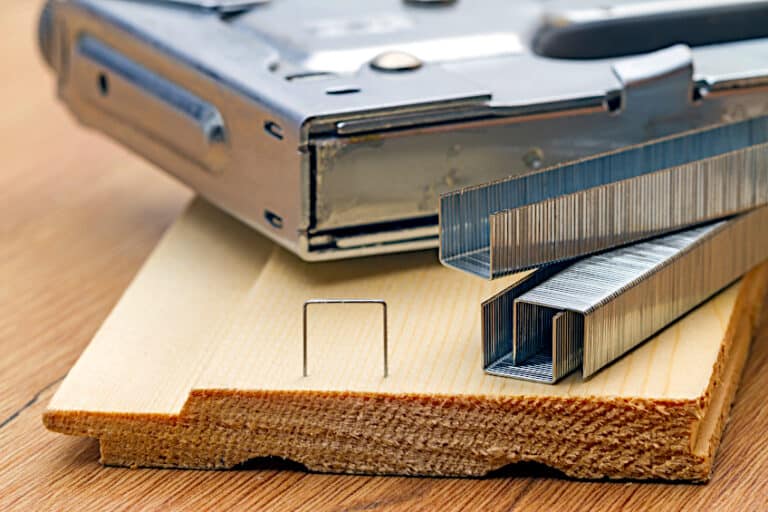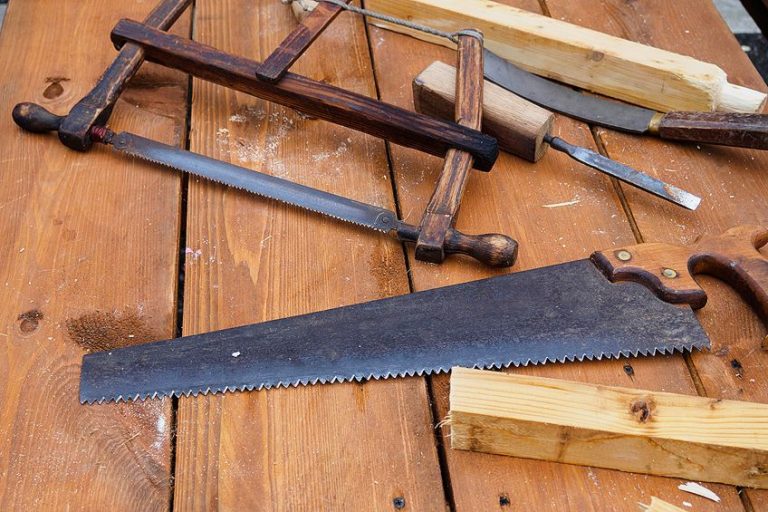How to Use a Drill Press – Everything you Need to Know
A drill press can be a very versatile tool, and if one has caught your interest you might have a few questions about them. The good news is that getting one will probably change the way you think about your craft and open your mind up to a new world of possibilities. The bad news? There are so many to choose from! This article will take you through everything you need to know about purchasing the best woodworking drill press.
Drill Press Basics
So, you want to drill holes in wood. The only problem is that you are unsure as to what the best tool for the job is, and your trusty handheld drill just will not cut it this time. In this case, a floor-mounted drill press might be exactly what you need to start making the holes you so crave, so we have devised a list of things you should know before giving in to your hardware buying impulses.
Remember, drill presses come in all shapes and sizes. For the sake of simplicity, we will be looking at floor-mounted drill presses specifically – how they work, where they can be found, what they do, and ultimately how they can benefit you.
What Is a Floor Standing Drill Press?
If you have ever been to a lumber yard, you have probably seen one of those massive wood saws. A floor-standing drill is much the same in its design, although instead of a wood saw, it has a drill unit that can be moved up or down on a Y-axis. The unit has a table and chuck attached to it that can be used to secure your workpiece, and this can be moved back and forth on an X-axis and even up and down, depending on your need.
These machines are typically used for large-scale manufacturing and high-volume output environments; however, they do come in smaller varieties for the avid craftsman and/or small business owner. These drill presses are mounted to the floor to ensure the stability and maneuverability of larger workpieces that would otherwise be challenging to manipulate, while also allowing you ample power and control over your immediate work environment.
Depending on the size and design of the press you choose to buy, installation can be challenging. Because of the semi-permanent nature of the drill press, it does require a substantial amount of space and is not easy to move around. Therefore, a floor-mounted drill press might not be the best option if mobility is important in your craft.
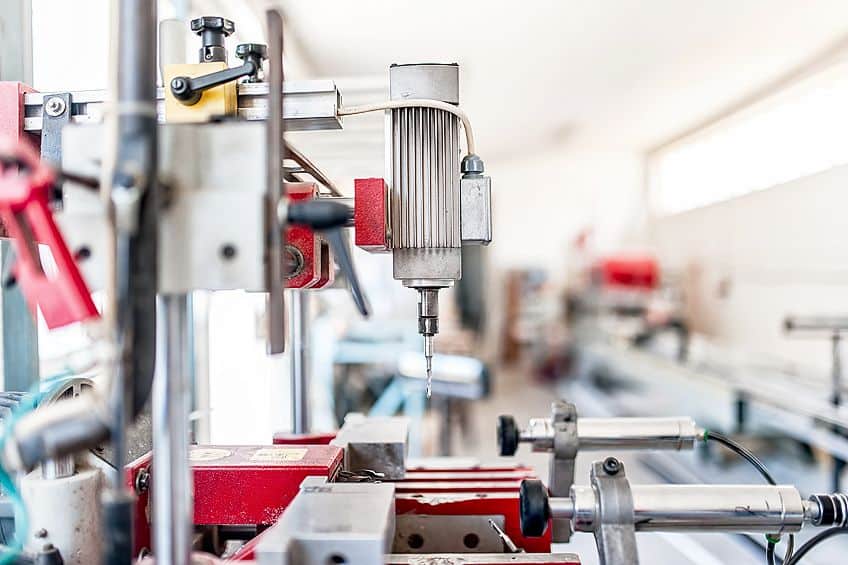
What is a Bench Top Drill Press?
Benchtop drill presses, table top drill presses, bench drill presses, hand drill presses, or whatever you like to call them are power tools primarily designed to bore very accurate holes into whatever piece of material you may be working with. They differ from standard portable drills in that they are permanently fixed to the top of your workbench and the machine is operated by means of a lever in a vertical downwards manner. The best benchtop drill press and drill press stand are usually purchased as one complete unit however it is possible to buy separate drill press stands if you already own a hand drill. We will discuss the differences a little later in this article.
A standard drill press is made up of a few main components: The base, column, table, and head. The base supports the machine and is used to secure the press to the workbench. The column, which is ideally made of steel, is secured to the base and holds the table and head. The table is secured to the column with a collar and can be adjusted vertically from the base right up to the head at the top of the press.
Depending on the model of drill press you purchase, some tables offer not only vertical adjustment while remaining parallel to the workbench but can be rotated and tilted for more drilling angle options. Lastly, the head is the actual motorized section of the whole assembly and holds the spindle and the chuck, which hold the interchangeable bits and allow you to drill into a material.
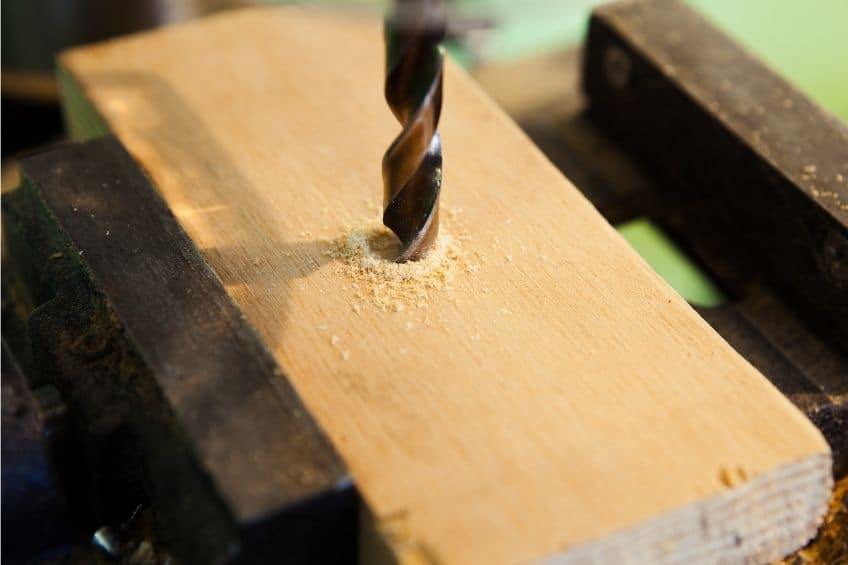
How to Operate a Bench Top Drill Press
Operating a drill press is a simple process but requires concentration and careful attention, as always when operating motorized machinery. With some planning and a few safety precautions, you’ll be on your way to creating your next masterpiece in no time.
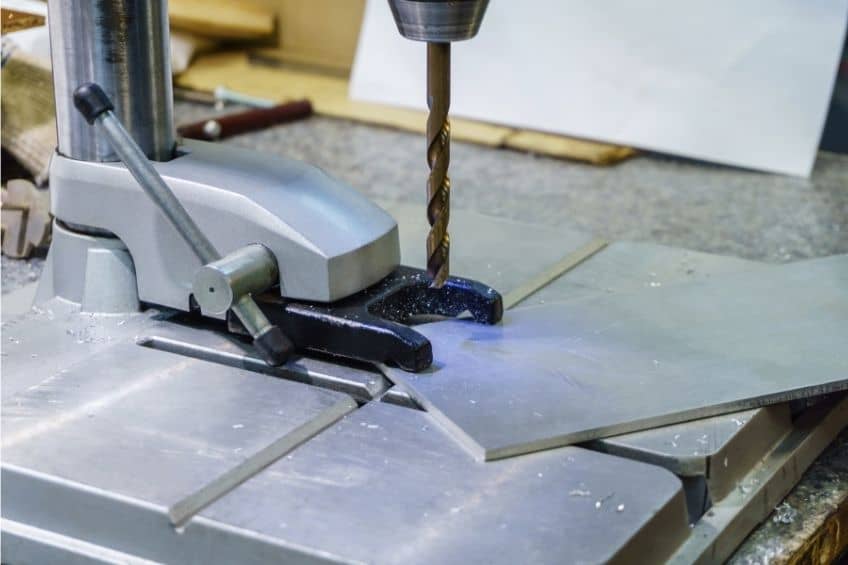
Prepare the Work Surface and Take Safety Precautions
Make sure that your workbench is clear of clutter and other hazards before attempting to operate the press. Also, make sure you have taken the necessary personal safety precautions: tie up long hair and don’t wear loose clothing or dangling jewelry, as these can easily become trapped in the spinning mechanism while working. Wear wrap-around safety goggles as well as a respiratory mask. Drilling into wood or metal gives off fine particles. Snug-fitting gloves are also recommended to prevent unnecessary injury from wood and metal burrs.
Secure Your Material
Whatever material you plan to work with, it will need to be securely fastened to your workbench with a clamp or two in order to drill into it, this ensures that the material will not move when drilled. If you are drilling into a piece of sheet metal that’s not securely clamped down, there is the potential for it to spin rapidly once the drill bit touches the material. This could result in serious injury. Make sure that you have a piece of fairly thick wood clamped between your table and the material you intend to drill. This will ensure that you don’t drill through into the table which could damage the drill bit.
Choose Your Drill Bit
Depending on the size of the hole you want to drill, insert your chosen drill bit into the chuck of the drill press. Tighten the chuck sufficiently to ensure that it will not slip while operating the press. If you are using a keyed chuck drill press, make sure to remove this key before turning on the machine to prevent potential injury.
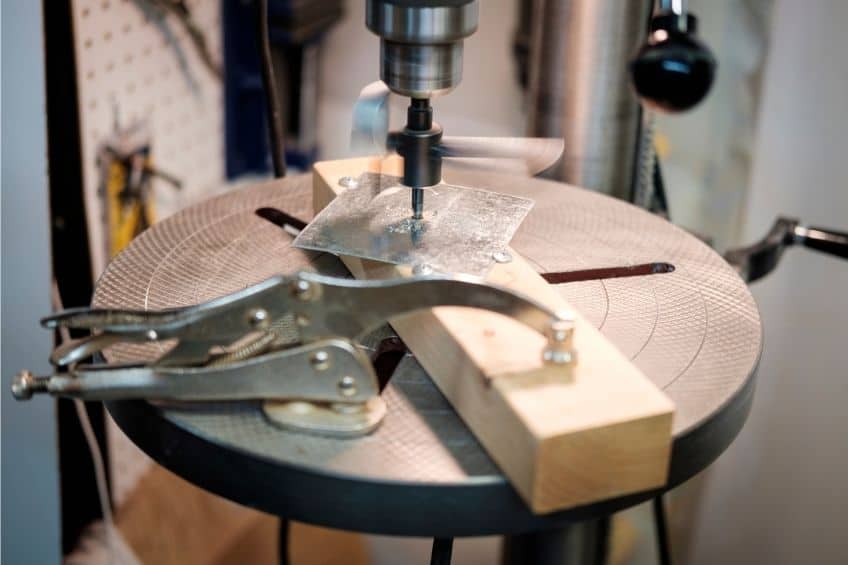
Choose the Desired Drill Press Settings
At this point, you can fine-tune all the other available settings on your press to your liking. The table height can be adjusted, the angle of the bit can be adjusted if your machine has this option and the machine’s speed setting can be chosen depending on the material you’re working with.
Turn On the Machine and Start the Drill
Once all the necessary safety precautions have been taken and you’re confident that the machine’s settings are correct, it’s time to drill into your material. You can now start the drill. Slowly operate the press handle in order to lower the drill bit until it comes into contact with your material. Apply pressure as needed but remember to let the equipment do the majority of the work. Too much pressure will result in the motor and drill bit overheating and will shorten the lifespan of the equipment. If you are needing too much pressure to do the job it’s likely that your drill bit is blunt and will need replacing.
Periodically stop drilling to clear the hole of debris. When you stop drilling, always slowly remove the spinning bit from the hole before turning off the machine. When starting the machine again, start it with the bit completely out of the hole and then lower the bit into the hole only once it’s up to full speed. This will prevent the sharp bit potentially snagging inside the hole and jamming.
Repeat the Process
Above are five simple steps for operating the best benchtop drill press. This process can obviously be repeated as much as you like but please remember to read the instruction manual provided with your drill press as each press will require slightly methods of operation as well as different care and maintenance routines.
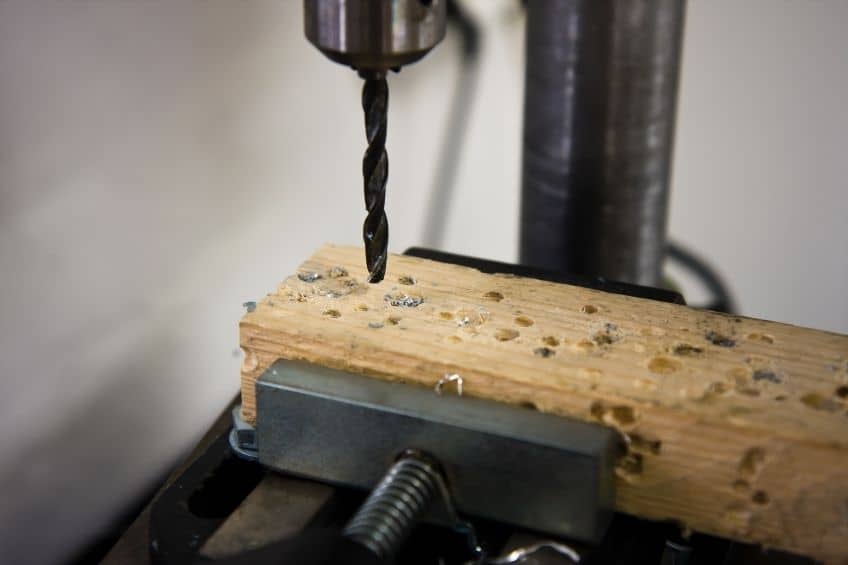
Other Helpful Tips and Tricks for Using a Drill Press
Depending on your skill level, there are some tips and tricks that can be useful in operating a drill press. Whether you work in mass production or are simply a hobbyist, there are little things you can do to improve both the longevity of your machine and the quality of your work. For your convenience, here are a few things we recommend for upping your drill press game.
- When working with wood or metal, mark your point of penetration with a center punch so the drill bit takes to the material a bit easier.
- When working with metal, use cutting fluid to ensure the longevity of your drill bit. This reduces the heat created in the cutting process and will also reduce the amount of bur!
- Use slower drilling speeds when attempting to penetrate a metal workpiece.
- Always clean your chuck and spindle before starting on another workpiece to ensure optimum output and accuracy.
- When drilling an exceptionally dense material, ensure that you rain the bit every once in a while to clear some of the material. This will reduce the resistance to the drill bit and improve the cutting experience.
- Keep an eye on the RPM of your machine. Going too fast or too slow on initial penetration with certain materials can cause unnecessary pressure on the machine and/or damage your drill bit. Always stick to the recommended RPM.

Safety Precautions When Operating a Drill Press
Before you get that credit card ready, there are a few drill press safety precautions you should be aware of before you hit “add to cart” online. It is important to remember that any drill press has the potential to be a danger to your hands, fingers, eyes, legs, and torso. Drill press injuries are no joke, so we highly recommend having a look at the information below.
Personal Protective Gear
Wearing the correct protective gear can be the difference between you walking away from operating the drill with a full set of fingers and undamaged eyes. The following personal protective equipment (PPE) should be worn at all times when operating a drill press of any kind.
- Regulation protective eyewear (safety goggles)
- An overall or other non-woven torso protection to protect against stray wood/metal shavings
- Steel tipped safety boots to protect your digits from any falling materials
- Regulation safety gloves. Ensure your sleeves are not exposed to prevent them from getting caught by the drill bit/ spindle
- Long hair should always be covered or tied back when operating a drill press
- Make sure that your clothing fits snugly but does not impair your mobility
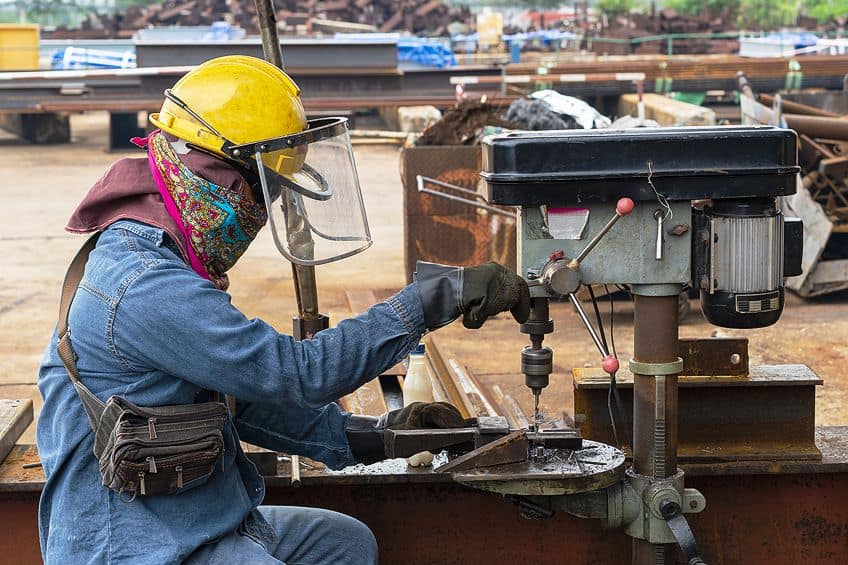
Standard Operation Safety Practices
It is of the utmost importance that you understand that the forces exerted by a drill press can fatally injure you if you are absent-minded or ignore safety precautions while operating these machines. Below are some basic safety tips that should always be followed while using a drill press.
- Make sure that you know the location of and can reach the drill power button.
- Ensure that you have removed the drill key from the chuck before operating the press.
- Be certain that your workpiece is clamped securely to the table of the drill before beginning.
- Never force a bit into a material. Instead, allow the bit to feed in at its natural pace at the recommended RPM.
- Do not try to slow the spindle or any other moving part down by hand.
- If your workpiece dislodges from the table clamps during the drilling process, stop the press immediately and do not attempt to salvage it.
- Keep your hands away from the workpiece, spindle, chuck, and drive belts during the drilling process.
- Never interact with any moving part while the machine is in operation.
- Do not clean off any of your clothing with compressed air as it could cause stray material to penetrate your skin.
Where Is a Floor Mounted Drill Press Used?
You do not need to be a genius to see how versatile these machines are, so you probably won’t be surprised to hear that they are typically used in environments that require high output and precision drilling. Typically, you can find them in most upholstery businesses, furniture manufacturing warehouses, woodwork emporiums, mechanical workshops, and even in factories that manufacture plastic goods.
What Are They Used On?
If you thought that these machines could only be used to tap and drill holes in wood, you are definitely not alone. Although they are typically used to manipulate wood for furniture, you can also use a drill press to design cutouts for specially commissioned construction projects such as countertops, light fixtures, door frames, and ceiling trims.
You might like to know that these machines can also be used to drill holes through metal for applications like modifying machine parts, bearings, and door hinges, and can even be used to tap threaded holes into objects for bolts and screws.
What Else Are They Capable Of?
One of the lesser-known applications for floor-mounted drill presses is that of modifying plastic. In some cases, they can be fitted with multiple spindles that can penetrate an object simultaneously instead of you having to raise and lower the chuck to drill each hole. As you can see, there are various materials that can be manipulated with a floor-mounted drill press and its applications are virtually limitless.
Advantages of Using a Floor-Mounted Drill Press
So, you know this tool can be used to drill through most commonly sold materials, but then again, so can your trusty handheld drill, right? Well, you’re not wrong; your old faithful has undoubtedly helped you hang countless curtain rails, pictures, key holders, and even secure the odd kitchen shelf here and there. However, there is one fatal flaw in your trustworthy hand drill that simply cannot be overlooked, and that flaw is (without prejudice)…you.
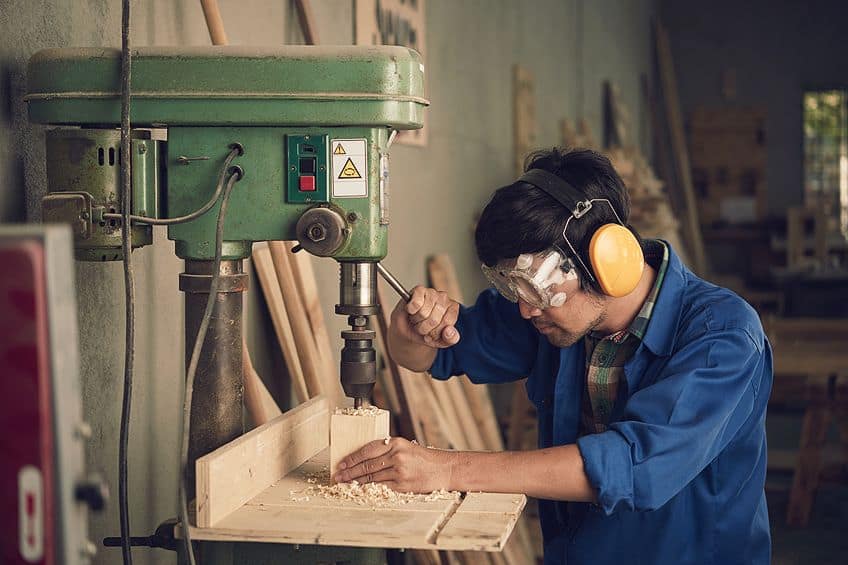
Consistency
As the saying goes, there are very few machine errors, mostly human errors. Your hand drill might be powerful and designed to drill through virtually anything you point it at, but your human tendencies very likely may the cause of certain mishaps. This is because the drill does not get tired, its eyes do not get strained, and its tendons don’t cramp when they have been stuck in one position for a long period of time.
At the end of the day, the accuracy, depth, and fluidity of the hole you are drilling are entirely dependent on your hands and eyesight, but with a floor-mounted drill, this is not the case.
Control and Accuracy
A floor-mounted drill not only gives you complete control and accuracy over the drill bit, but also allows you to secure, offset, and center your workpiece. We mentioned previously that the floor-mounted drill is not exactly what you would call portable, but as a trade-off, it provides unparalleled precision and perfect drilling depth with every single plunge. Other benefits include an adjustable three-tooth chuck and a removable spindle that can be used to equip attachments such as circular cutting blades, external thread dies, and internal thread taps.
Which Drill Press Is Right for You?
There can be a lot to consider when looking for a floor-mounted drill press. Since space comes at a premium these days, size is a big factor in the decision-making process.
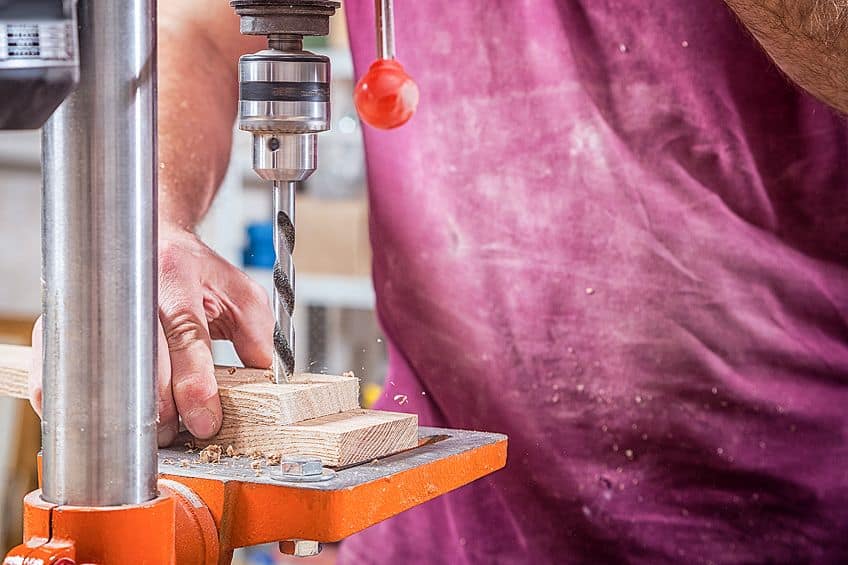
What to Look for When Buying a Drill Press
There are a lot of things to consider when deciding which drill press is right for you. As we stated previously, space comes at a premium these days and a floor-mounted drill press can eat up real estate pretty quickly if you don’t know what you are doing. This is just one of many factors to consider when deciding which machine will suit your needs.
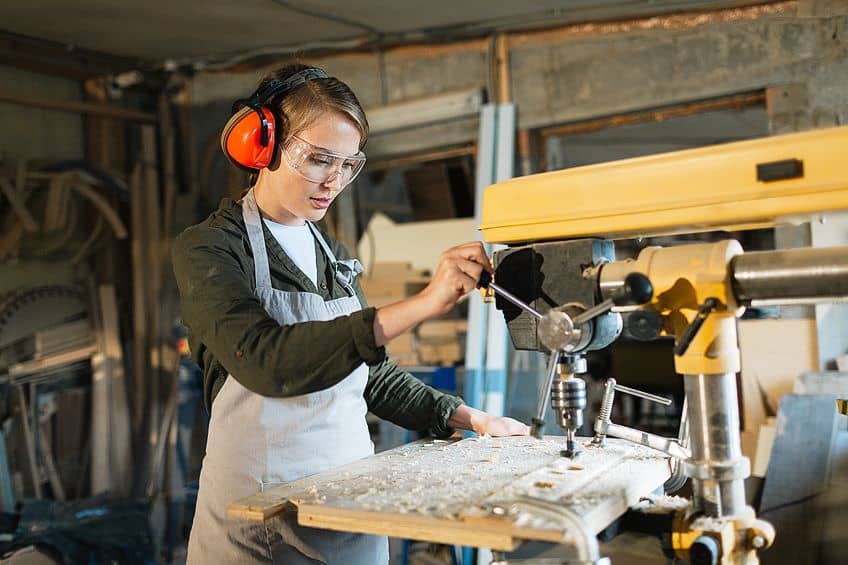
Available Space
The distinctions between needs, want, and practicality can leave even the most experienced craftsman as frustrated as a two-year-old trying to understand why they can’t have the toy they want. It is important to be realistic not only about the space you have available, but also the type of work you will be doing the most.
A floor model drill press is an impressive and useful tool to have in your arsenal, but if all it is going to be doing is standing idle in your workspace for five days out of the week, then you are essentially depriving yourself of perfectly good space, not to mention losing money on quite a big investment (depending on which unit you purchase).
Consider the size of the drill press you have your eyes on versus how often you will really be using it, and ultimately whether you can justify buying it in comparison to something like a bench-mounted press.
Application
We all know that having the right tool for the job is often what separates a good workpiece from a great workpiece. You might love your trusty hand drill and revel in all the adventures the two of you have had together, but every tool has its limitation and when push comes to shove, your beloved sidekick will not be drilling through reinforced steel or re-tapping threads on an engine block.
Considering the average size of your workpieces and the volume of the work you do can go a long way in narrowing down which drill press is right for you. Will you be doing a lot of cutting? How often do you find your current drill setup to be inadequate in accommodating the size of your workpiece? What power output would be best for your needs? Do you need a workbench that can be positioned to 90 degrees or 45 degrees?
Needs versus Luxury
We are sure that you have an idea of what your ideal drill setup would be, but this is not always indicative of what your needs are. As we stated previously, it is important to be realistic about the type of work you do regularly as well as what your skill level and applications are. Once you have these narrowed down, you should then consider things like chuck size, the adjustability of your table, and the power and speed of the machine.
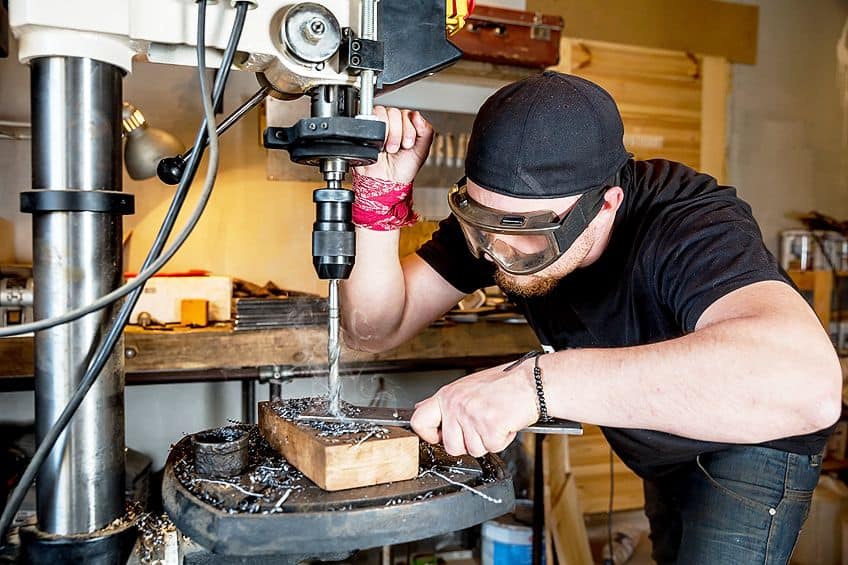
Chuck Size
The size of your chuck essentially determines what kind of bits and other attachments you will be able to use on your floor model drill press. Some chucks are highly adjustable and are able to accept a wide variety of tools, however, these can cost more than those that are limited to standard bits, taps, and so forth. You should also keep in mind that presses with keyless chucks will cost a bit more as this is seen as a luxury, although in our opinion, it sure beats pulling your hair out trying to remember where you put your chuck key.
Table Adjustability
Your drilling table is arguably one of the most important and often overlooked parts of the floor-mounted drill press. A good table often has features to assist in both securing the workpiece and marking where the bit will penetrate, typically with a laser guide. Drill press tables used to be produced in cast iron as a standard in order to ensure sturdiness and therefore had the added benefit of vibration reduction due to the density of the metal. These days, if you are willing to fork out a bit more cash, you can have a table that can tilt all the way from 45 degrees to 90 degrees if you need to drill at an awkward angle.
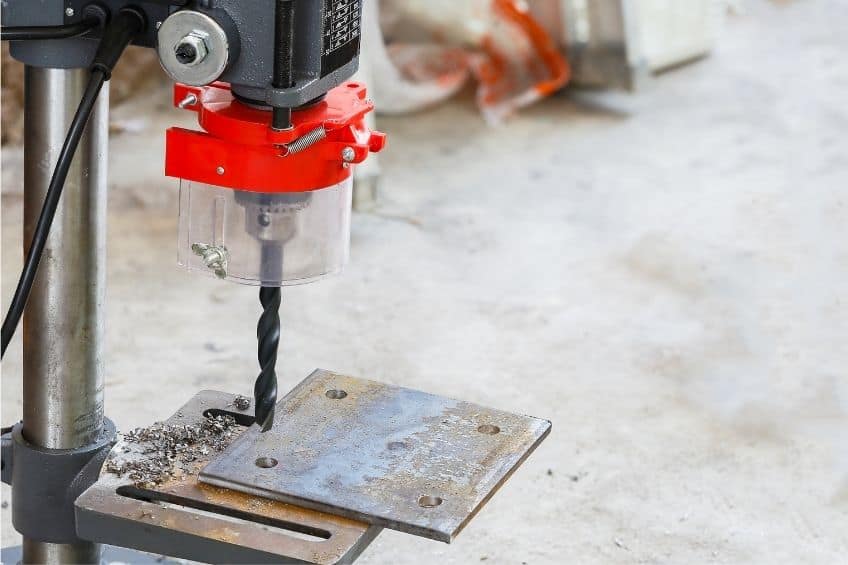
Power and Speed
Most floor drill press reviews will let you know that the maximum power and speed of your machine will dictate what kind of work you will be able to do with it. However, big power is not always all that it’s cracked up to be and can come with some drawbacks. For instance, drills have small motors, so what they lack in torque they make up for in RPM. The higher the maximum RPM of a drill, the higher the horsepower output, but with a small motor revving to those speeds, it can make for quite a noisy environment.
Consider whether the materials you are working with require a drill with a high RPM, and always keep in mind that your neighbors might not like your new machine as much as you do.
Bench Drill Press versus Floor Drill Press
If you are still unsure as to whether a floor-mounted drill press is a good choice for you, there is no need to panic. If you don’t plan on using a dedicated drilling unit for long or simply do not have the space to accommodate a floor-standing drill press, you always have the option of installing a good old-fashioned bench press. To assess which option is best for you, we have created a list below detailing the advantages and disadvantages of each.
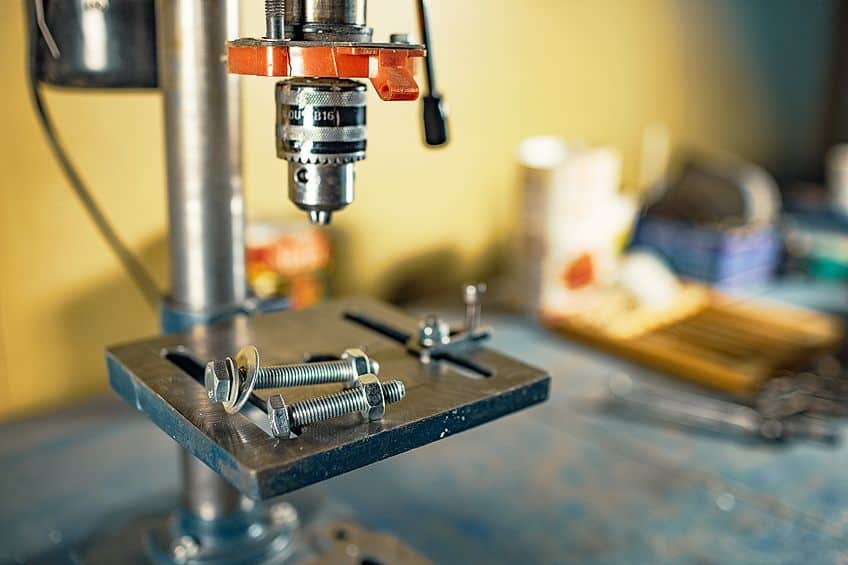
Bench Mounted Drill Press
A bench-mounted drill press is commonly known for being the best drill press for woodworking, particularly for small workpieces such as boutique furniture units and wooden ornaments. These presses are compact, easy to install, and much less expensive than floor-mounted drill presses.
PROS
- Compact design
- Lightweight
- Easy to install
- Easier to travel with
- Often less noisy than a floor-mounted drill press
- Well-suited for woodworking
CONS
- Spindle depth can be shallow
- Not ideal for larger workpieces
- Far less powerful than a floor-mounted drill press
- Tables are smaller and securing your workpiece can be tricky
Floor Standing Drill Press
Considering we are this far in, you probably know what the bench-mounted press is up against, but in the interest of being comprehensive (which we pride ourselves on), here are some facts for comparison and some things you might have missed!
PROS
- Extremely powerful
- Can be used for sanding and tapping purposes too
- Able to maintain higher drilling and cutting speeds
- Capable of accommodating larger workpieces
- Spindles are capable of penetrating much further than bench presses
- Drilling tables are adjustable to angles from 45 degrees to 90 degrees, depending on the make and model
CONS
- Can cost twice that of a bench drill
- Units that operate at a high RPM can be quite loud
- Takes up a considerable amount of space
- Replacing parts outside of warranty can be expensive
- Higher-end models have the best features and those below a certain price range will be relatively basic and often not much of an upgrade from a bench drill
Wrapping Your Head Around Everything
We have no idea what your state of mind was when you started reading this, but we certainly hope that this article has helped you make a more informed decision regarding what drill press best suits your needs and craft. There are many variables to consider, including space, price, features, performance, power output, and even aesthetics.
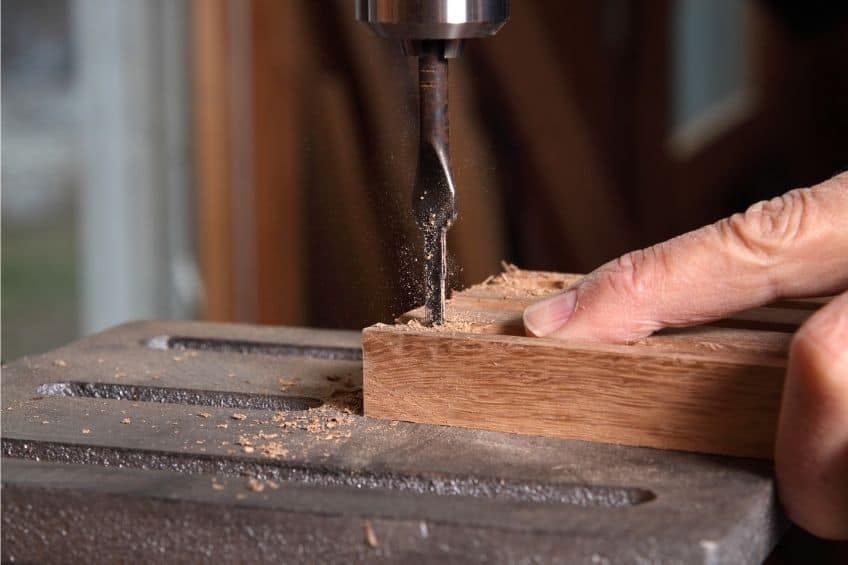
So, now that you are armed with all the information you could ever need to know about drill presses, there is nothing stopping you from going out and making the world a slightly better place with some marvelous creations. Remember to choose what suits your needs and your pocket, thoroughly check floor drill press reviews, and always keep safety first!
Frequently Asked Questions
How Do I Make My Drill Press Mobile?
People typically get a floor-mounted drill press because they need something that is a bit more rouged and powerful than a bench-mounted drill. However, there are many sources online that show you how to add a wheeled platform underneath your drill (or build an entire wheeled cabinet around it) in order to make it mobile. This grants you moderate mobility without having to compromise on power, which is an absolute win in our book.
Does a Drill Press Need to Be Mounted to the Floor?
This does depend on what kind of work you will be doing. Drill presses naturally have a high center of gravity, which means that if the top is tilted past a certain point, it can fall over. However, this is highly unlikely. There are advantages to securing your drill press such as vibration reduction and increased stability, but it is nice to have the option to move it to a different spot should the need arise without having to unfasten it.
How Do You Size A Drill Press?
A drill press is measured by way of the swing. Essentially, all you have to do is measure the distance from the center spindle to the end of the main column. Take this measurement and multiply it by two and you will have the swing, which is the engineering measurement term for the size of a given drill press unit.
Why Do You Need a Tabletop Drill Press?
A tabletop drill press offers unparalleled accuracy and precision over a handheld drill. With a tabletop drill press, you can be guaranteed arrow-straight holes of precise depths every time.
How Much Power Do You Need for a Benchtop Drill Press?
How much power you need depends on what material you will be working with. If you are looking to work with a soft wood like pine then you don’t need all that much power. A motor with a low amperage of 2 to 4 amps will suffice as you don’t need a lot of torque to drill into soft materials.
What Speed Options are Best for a Drill Press?
The amount of speeds needed on your drill press again depends on the material you’ll be working with. If you are going to be drilling into a hard material like steel, then look for a variable speed drill press with a few options for low-speed settings. A steel bit drilling into steel will heat up very quickly which is why you will need to work at a low speed. Another must-have drill press feature when looking to work with hard metals is the option to allow a liquid coolant to flow over the hole you will be drilling. This coolant prevents the bit overheating while working.
What is Drill Press Swing?
Swing refers to the distance from the central column of the drill press to where the bit meets the center of the table. If the press has a swing of 10 inches, this would mean that you can drill a hole in the center of a square or circular piece of material with a diameter of 10 inches.
Do Benchtop Drill Presses Need a Lot of Maintenance?
Drill presses generally need very little maintenance. It’s always a good idea to wipe them down after every use to get rid of debris and fine particles that over time could get into the motor assembly. Applying lubrication to the chuck mechanism and other external moving metal parts is recommended to keep these in good working order.
How Long Do Benchtop Drill Presses Last?
With a little regular maintenance as mentioned above, as well as correct operation like not using too much unnecessary pressure when drilling, your drill press should serve you well for many years. Bear in mind that as with most things, you get what you pay for. Compare several drill presses in your budget. Presses that are much cheaper while still offering the same features as the competition may have inferior components which will fail much sooner.

I have been into woodworking since 2005 and woodturning since 2011. Because of my love for wood and woodworking, I started woodhappen.com to teach other enthusiasts about how to finish and seal wood, the best woodworking tools, the different types of wood, and everything else related to woodworking! Read more about me here.

